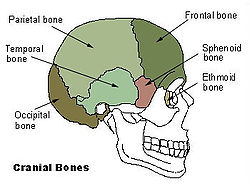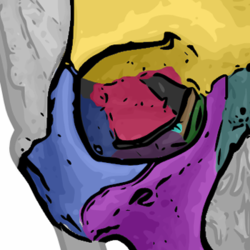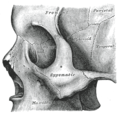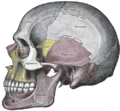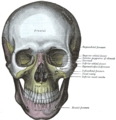- Ethmoid bone
-
Bone: Ethmoid bone Cranial bones The seven bones which articulate to form the orbit. (Ethmoid is brown) Latin os ethmoidale Gray's subject #36 153 MeSH Ethmoid+bone The ethmoid bone (from Greek ethmos, "sieve") is a bone in the skull that separates the nasal cavity from the brain. As such, it is located at the roof of the nose, between the two orbits. The cubical bone is lightweight due to a spongy construction. The ethmoid bone is one of the bones that makes up the orbit of the eye. The ethmoid has three parts: the cribriform plate, the ethmodial labyrinth, and the perpendicular plate
Contents
Articulations
The ethmoid articulates with fifteen bones:
- four of the neurocranium—the frontal, and the sphenoid (at the sphenoidal body and at the sphenoidal conchae).
- eleven of the viscerocranium—, two Nasal bones, two maxillae, two lacrimals, two palatines, two inferior nasal conchae, and the vomer
Injuries
Fracture of the lamina papyracea, the lateral plate of the ethmoid labyrinth bone, permits communication between the nasal cavity and the ipsilateral orbit through the inferomedial orbital wall, resulting in orbital emphysema. Increased pressure within the nasal cavity, as seen during sneezing, for example, leads to temporary exophthalmos.
The porous, fragile nature of the ethmoid bone makes it particularly susceptible to fractures. The ethmoid is usually fractured from an upward force to the nose. This could occur by hitting the dashboard in a car crash or landing on the ground after a fall. The ethmoid fracture can produce bone fragments that penetrate the cribriform plate. This trauma can lead to a leak of cerebral spinal fluid into the nasal cavity. These openings allow for opportunistic bacteria in the nasal cavity to enter the sterile environment of the central nervous system (CNS). The CNS is usually protected by the blood brain barrier, but holes in the cribriform plate allow bacteria to surpass the barrier. The blood brain barrier makes it extremely difficult to treat such infections because only certain drugs can cross in the CNS.
An ethmoid fracture can also sever the olfactory nerve. This injury results in anosmia, or the loss of smell. A reduction in the ability to taste is also a side effect because it is based so heavily on smell. This injury is not fatal.
Role in magnetoception
Main article: MagnetoceptionSome birds and other migratory animals have deposits of biological magnetite in their ethmoid bones which allow them to sense the direction of the Earth's magnetic field. Humans have a similar magnetite deposit, but it is believed to be vestigial.[1]
Additional images
-
Lateral wall of nasal cavity, showing ethmoid bone in position.
See also
- Ossification of ethmoid
- Bone terminology
- Terms for anatomical location
References
- ^ Nature 301, 78 - 80 (06 January 1983); doi:10.1038/301078a0
2. Saladin, Kenneth S. "Anatomy and Physiology: the Unity of Form and Function" McGraw Hill, 5th ed. New York: 2010
3. Banks, Peter. "Fractures of the Facial Skeleton" Elsevier Health Sciences, 2001
External links
- http://www.theregister.com/2006/11/17/the_odd_body_nose_compass/
- Roche Lexicon - illustrated navigator, at Elsevier 34256.000-1
This article was originally based on an entry from a public domain edition of Gray's Anatomy. As such, some of the information contained within it may be outdated.
The Bones which form the Orbit Frontal bone • Zygomatic bone • Maxillary bone • Sphenoid bone • Ethmoid bone • Palatine bone • Lacrimal bone Categories:
Categories:- Bones of the head and neck
Wikimedia Foundation. 2010.

